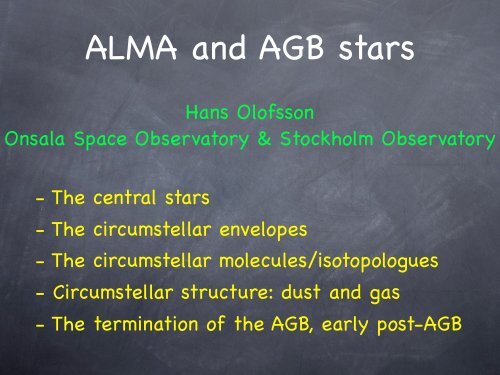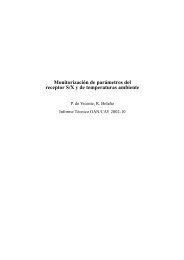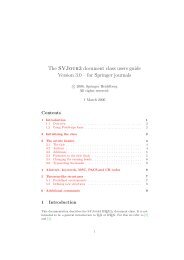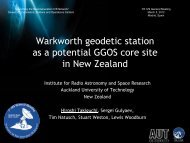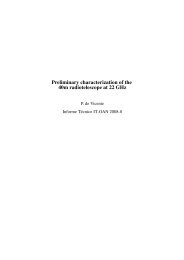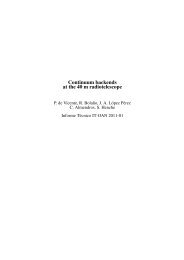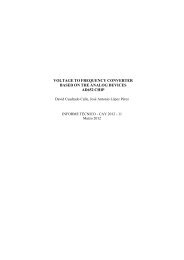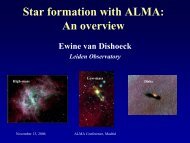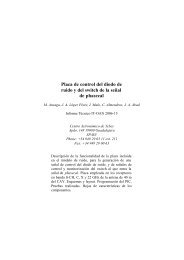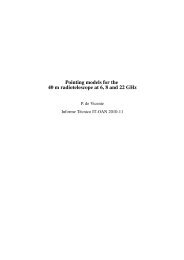The central stars
The central stars
The central stars
You also want an ePaper? Increase the reach of your titles
YUMPU automatically turns print PDFs into web optimized ePapers that Google loves.
ALMA and AGB <strong>stars</strong>Hans OlofssonOnsala Space Observatory & Stockholm Observatory- <strong>The</strong> <strong>central</strong> <strong>stars</strong>- <strong>The</strong> circumstellar envelopes- <strong>The</strong> circumstellar molecules/isotopologues- Circumstellar structure: dust and gas- <strong>The</strong> termination of the AGB, early post-AGB
<strong>The</strong> importance of AGB <strong>stars</strong>- <strong>The</strong> final stellar evolutionary stage for <strong>stars</strong> inthe mass range ≈0.8-8 M sun=> the majority of all <strong>stars</strong> that have died inour universe have done this as AGB <strong>stars</strong>- <strong>The</strong>y have a large mass return and so areimportant for the cosmic gas/dust cycle:- they produce heavy elements (3α, s-process)- they produce dust particles- they produce complex molecules (PAHs, ...)
<strong>The</strong> importance of AGB <strong>stars</strong>- <strong>The</strong>y are very luminous and old=> probes of galaxy structure, kinematics, andSF history- <strong>The</strong>ir CSEs provide excellent astrophysical andastrochemical laboratories- <strong>The</strong>y are intricate objects=> a full description requires a complex interplaybetween different physical/chemical processeswith different time scales
<strong>The</strong> structure of an AGB-objectmass loss determinednucleosynthesis region10 11 in size10 7 in temp.10 29 in density
<strong>The</strong> stellar mass loss<strong>The</strong> mass loss is the process that determines it all:- the lifetime on the AGB- the luminosity reached- the gas/dust return- the chemical composition of the returned gas<strong>The</strong> probes of this process are:- circumstellar atomic/molecular line emission- circumstellar dust continuum emission
AGB <strong>stars</strong> are dynamical objects<strong>The</strong> angular resolution of ALMA fits well theimportant time scales of AGB <strong>stars</strong>:θ t ≈ v etD ≈ 0.3 [t100 yr] [ 1 kpcD]arcs- stellar pulsation 1 yrο Ceti visual lightcurve- super-period effects 5 yr- clump ejection 1 yr- gas-dust interaction < 100 yr- thermal pulsing 10 2-3 yr and 10 4-5 yr- termination of AGB < 100 yr
AGB <strong>stars</strong> are dynamical objectsThis applies even more to post-AGB objects:- fast winds- bipolar outflows- jets- shocks- ionization fronts- dissociation fronts
ALMA and the <strong>central</strong> <strong>stars</strong>Observational space:S ∗,lowL ≈ 0.5[ ν230] 2[ 1 kpcD] 2mJyL=4000 L sun , T e =2800K[ ν] 2[ 1 kpc] 2mJyS ∗,highL ≈ 4230DL=15000 L sun , T e =2200KObservational space (1 hour, 5σ = 85 µJy, 230 GHz):D ∗,lowL ≈ 3 kpcD ∗,highL ≈ 8 kpcNote: S 350 ≈ 2 S 230 , andN 350 ≈ 2 N 230
ALMA and the <strong>central</strong> <strong>stars</strong>Size (tens of convection cells per star is expected):θ ∗,lowL ≈ 5[ 1 kpc]Dmassimulation[ 1 kpc]θ ∗,highL ≈ 15DmasD > 50 pc =>θ * < 0.1 arcs0.02 arcs, 1 hour, 230 GHz,5σ = 5 K
ALMA and the <strong>central</strong> <strong>stars</strong>A “radio photosphere” appears to exist, and it islarger than R (≈2R ; Reid & Menten)* *α Ori, VLA, 7 mmsize ≈ 0.1”S ≈ 28 mJyT b ≈ 3500 KExcellent probe ofthe complicated,inhomogeneous stellarLim et al. Nature 392, 575atmosphere
ALMA and the CSEsM(t,θ,φ,M MS ,Z,P, ...) & dN/dMv exp (t,θ,φ,M MS ,Z,P, ...)
ALMA and the CSEsFlux density of a dusty CSE (optically thin):S CSE,d ≈ 15[Ṁ10 −6 ] [ ν230] 3[ 1 kpcD] 2mJyObservational space, 1 hour (5σ = 85 µJy, 230 GHz):D CSE,d ≈ 13[Ṁ10 −6 ] 0.5kpc Note: S 350 ≈ 4 S 230 , whileN 350 ≈ 2 N 230- 10 -7 M sun /yr in GC in 4 hours- 10 -5 M sun /yr in LMC in 2 hours
ALMA and the CSEsNote thatS ∗ ∝ ν 2 while S CSE,d ∝ ν 3S CSES CSES *≈ 80 GHz at 10 -7 M sun /yr≈ 6 GHz at 10 -5 M sun /yrbut the brightnessdistributions arevery different
ALMA and the CSEsFlux density of a gaseous CSE:S CO(2−1) ≈ 6[Ṁ10 −6 ] 1.2 [ 15 km s−1v e] 1.6 [ ] 0.7 [ ] 2 fCO 1 kpc10 −3 JyD(based on detailed modelling by Ramstedt et al., in prep.)S CO(3−2) ≥ 2 S CO(2−1) at low ṀS CO(3−2) ≈ S CO(2−1) at high ṀNote: N 345 ≈ 2 N 230
ALMA and the CSEsObservational space (1 hour, 2 km/s, 5σ = 6 mJy):D CO(2−1) ≈ 30[Ṁ10 −6 ] 0.6 [ 15 km s−1v e] 0.8 [fCO10 −3 ] 0.4kpc- 10 -7 M sun /yr in GC in 1 hours- 10 -6 M sun /yr in LMC in 4 hours- 10 -5 M sun /yr in M31 in 40 hours
ALMA and the CSEs!! Iso-distance samples are very important !!M vs P(M MS )dN/dMM-<strong>stars</strong>C-<strong>stars</strong>M vs v expM-<strong>stars</strong>C-<strong>stars</strong>
ALMA and the CSEsSizes of the emitting regions:B CSE,d (p) ∝ p −1.4⎡θ CO ≈ 5 ⎣0.1 + 0.9sharply peaked at the centre, butextend much further thanmolecule-CSEs, and is opticallythin even at high mass-loss rates( ) ⎤ 0.7Ṁ⎦10 −6[ 1 kpcD]arcsphotodiss.radiusθ CO (8 kpc, 10 −6 M ⊙ /yr) ≈ 0.5 arcsθ CO (50 kpc, 10 −5 M ⊙ /yr) ≈ 0.5 arcsθ mol ≤ 0.1 θ COnormallysharplypeaked atthe centre
CO brightness distributionsPdB large project, syst. vel. maps, Castro-Carrizo et al.30”V Cyg CO(1-0) TX Cam CO(1-0) TX Cam CO(2-1)to60”insizeR Cas CO(1-0) V Hya CO(1-0) X Her CO(1-0)
Circumstellar molecules∑ = 69 circ. speciesunique to post-AGB, ∑ = 11CH, CH + , CO + , H 2 , N 2 H + ,OCS, HC 4 H, HC 6 H,CH 3 C 2 H, CH 3 C 4 H, C 6 H 6= only IRC+10216* !!!!*IRC+10216: the mostnearby C-star, and it hasa high mass-loss rate
Circumstellar molecules, brightness distributionsIRAM PdB data towardsIRC+10216(Guelin et al. 1996)Some molecules are ofphotospheric origin (e.g., SiS),some are photodissociationproducts (e.g., CN), andsome are due to circumstellarchemistry (e.g., HNC)For chemical reasons,these emissions shouldnot coincide (Guelin etal. 1993).
Circumstellar SiO abundance estimatesCircumst. SiO abund. of 43 M- and 17 C-type <strong>stars</strong>Only detailed study of a species in a large sample of <strong>stars</strong>and R For overlayed on observed spectra (histograms).f SiO3 orders of magnitudespread in abundanceabundance in C-<strong>stars</strong>>> eq. value, while in M-<strong>stars</strong> it is
Circumstellar SiO abundance estimatesRad. transf. modelling of interferometric SiO dataR Dorsingle-dishmodelcompact and extended comp.only compactcomp.red line is the best-fitmodel using:i) a compact highabundance(4x10 -5 )region (eq. value)ii) an extended lowabundance(3x10 -6 )region (SiO depleted)Schöier et al. A&A 422, 651, 2004
Circumstellar isotope ratiosEven a simple analysis is expected to give reliableresults as long as optically thin lines are used, providedno chemical/excitation differencesIsotope ratios can beestimated for the highlyobscured objectsMany of these ratiosare difficult todetermine from optical/IR datanX/ m X as a fcn of time
ALMA and the CSEsDetectability of molecular species:[ ] [ ] [ ] [ ] 2 fX Ṁ R e 15 e −E l/kT xS ≈ 6 g u A ul10 −8 10 −6 10 16 cm v e Q(T x )[ ] 2 1 kpcJyDExample:H 2 CO(3 12 -2 11 ) at 226 GHz4 km/s, 1 hour => S(5σ) = 4 mJyf X ≈ 1x10 -8 , 10 -5 M sun /yr, out to 1 kpc(IRC+10216 lies at ≈120 pc)
ALMA and the circumstellar structure<strong>The</strong> detailed density distribution is very importantfor deriving mass-loss rates, abundances, ..., andfor comparison with chemical modelsClump characteristics (not well known):size ≈ 10 13 cmn ≤ 10 11 cm −3}→ M cl ≈ 10 −6 M ⊙[ 1 kpc]θ cl ≥ 0.5Dmas
ALMA and the circumstellar structureClump optical depths and flux densities:τ d,cl ≈ 0.1[Mcl10 −6 ] [ 1013r clS d,cl ≈ 0.006[ ] [ ] [ ] [ ]Mcl Td ν 321 kpc10 −6 mJy1000 230 D] 2 [ ν230]τ CO,cl ≈ 100[Mcl10 −6 ] [ 1013] 2 [ ] 2 10002 → 1 liner cl T xS CO,cl ≈ 0.03[Mcl10 −6 ] [ 1000T x] [ ] 2 1 kpcmJy 2 → 1 lineDNote that S masers >> S CO,cl
ALMA and the circumstellar structureExample, IRC+10216, θ cl ≥ 0.01 arcs:S b,d ≈ 0.4 mJy at 230 GHz5σ ≈ 0.085 μJy in 1 hour, 0.02 arcs res.S CO(2-1),l ≈ 2 mJy5σ ≈ 4 mJy in 1 hour, 0.02 arcs and 2 km/s res.Time-resolved chemistry of both dustand gas, including their interaction
Imaging of molecules and dustIRC+10216 inscattered interstellar lightmolecular line intensity peakson scattered lightMauron & Huggins
Comparisons of gas and dust distributionsR Scl HST/ACS imagef606wshell diameter ≈ 38”shell age ≈ 1800 yrTT Cyg PdB mapshell diameter = 68”shell age ≈ 8000 yrCO(1-0)
Termination of the AGB phaseM st.env /M < 10-100 yr at the endM(θ,φ,t)v e (t); drastic changes?<strong>The</strong> emergence of jets<strong>The</strong> shaping of planetary nebulaeNGC6543
Termination of the AGB phaseIRC+10216AGB starCO(3-2)HD101584, post-AGB(?)12 CO(2-1)CRL618post-AGBCO(2-1)at leastthreekinematicalfeatures13 CO(2-1)bipolar outflow400 km/s300 km/s
Termination of the AGB phase8. Attachments (Figures)Fig. 1: Illustration of the magnetic field collimating the 22 GHz H2O maser jet of W43A. <strong>The</strong> toroidal field isindicated by the ellipses around the precessing jet. <strong>The</strong> ellipses are scaled with magnetic field strength. <strong>The</strong>solid black circles denote the observed H2O masers and the vectors are the direction of the magnetic field asdetermined from the maser linear polarization.He2-47, young PNHST imageSahai & TraugerFig. 2: <strong>The</strong> biconical distribution of the 43 GHz SiO masers close to the stellar photosphere of W43A.- 4 -8. Attachments (Figures)W43A, OH/IR starFig. 1: Illustration of the magnetic field collimating the 22 GHz H 2 O maser jet of W43A. <strong>The</strong> toroidal field isVLBA imageImai et al.Magnetic collimationindicated by the ellipses around the precessing jet. <strong>The</strong> ellipses are scaled with magnetic field strength. <strong>The</strong>solid black circles denote the observed H 2 O masers and the vectors are the direction of the magnetic field asdetermined from the maser linear polarization.(H 2 O, 22 GHz, pol)Vlemmings et al.
Post-AGB circumstellar chemistry11 species are unique to the post-AGB circumstellar medium:CH, CH + , CO + , H 2 , N 2 H + , OCS,HC 4 H, HC 6 H,CH 3 C 2 H, CH 3 C 4 H,C 6 H 6- Increased temperature- Increased UV flux- Presence of shocksstimulates a rich and complex chemistry
initial (pre-condensation) SiO abundance determined by the stellaratmosphere chemistry, possibly modified by non-LTE chemicalprocesses due to shocks in the inner part of the wind out toa few stellar radii (e.g., Willacy & Cherchneff 1998). In terms ofclassical evaporation theory (see González Delgado et al. 2003,and references therein) the region over which the SiO abundanceis expected to change significantly due to condensationonto dust grains is confined within approximately 10 15 cm. Forintermediate- to high-mass-loss-rate objects this region is significantlysmaller than the post-condensation region (see Fig. 5),which is limited by photodissociation, and it does not contributenotably to the observed single-dish fluxes. Thus, a single componentis adequate for describing the SiO abundance structurein this case. It should be pointed out that this also means thatno constraints can be put on the pre-condensation abundancefrom the present observations. This requires high spatial resolutionobservations (Schöier et al. 2004). In the case of low-massloss-rateobjects the post-condensation region is smaller, but,since the freeze out is less effective, the contrast between preandpost-condensation SiO abundances is small. Hence, a singleALMA and AGB <strong>stars</strong>252 F. L. Schöier et al.: SiO in C-rich circumstellar envelopes of AGB <strong>stars</strong>Table 4. SiO abundance distribution.Sourcef 0aar e N χ 2 red[cm]S Cep 1.4 ± 0.8 × 10 −5 4.4 ± 1.6 × 10 15 5 0.6V Cyg 1.3 ± 0.7 × 10 −5 3.6 ± 1.3 × 10 15 6 2.0R For 2.2 ± 1.8 × 10 −5 5.4 ± 3.6 × 10 15 4 0.3CW Leo 2.8 ± 1.1 × 10 −7 1.9 ± 0.7 × 10 16 9 0.8R Lep 3.1 ± 1.4 × 10 −6 4.4 ± 1.6 × 10 15 4 0.9RW LMi 6.0 ± 4.0 × 10 −6 7.7 ± 2.5 × 10 15 5 1.1a <strong>The</strong> abundance distribution is assumed to be Gaussian (see Eq. (3)).


